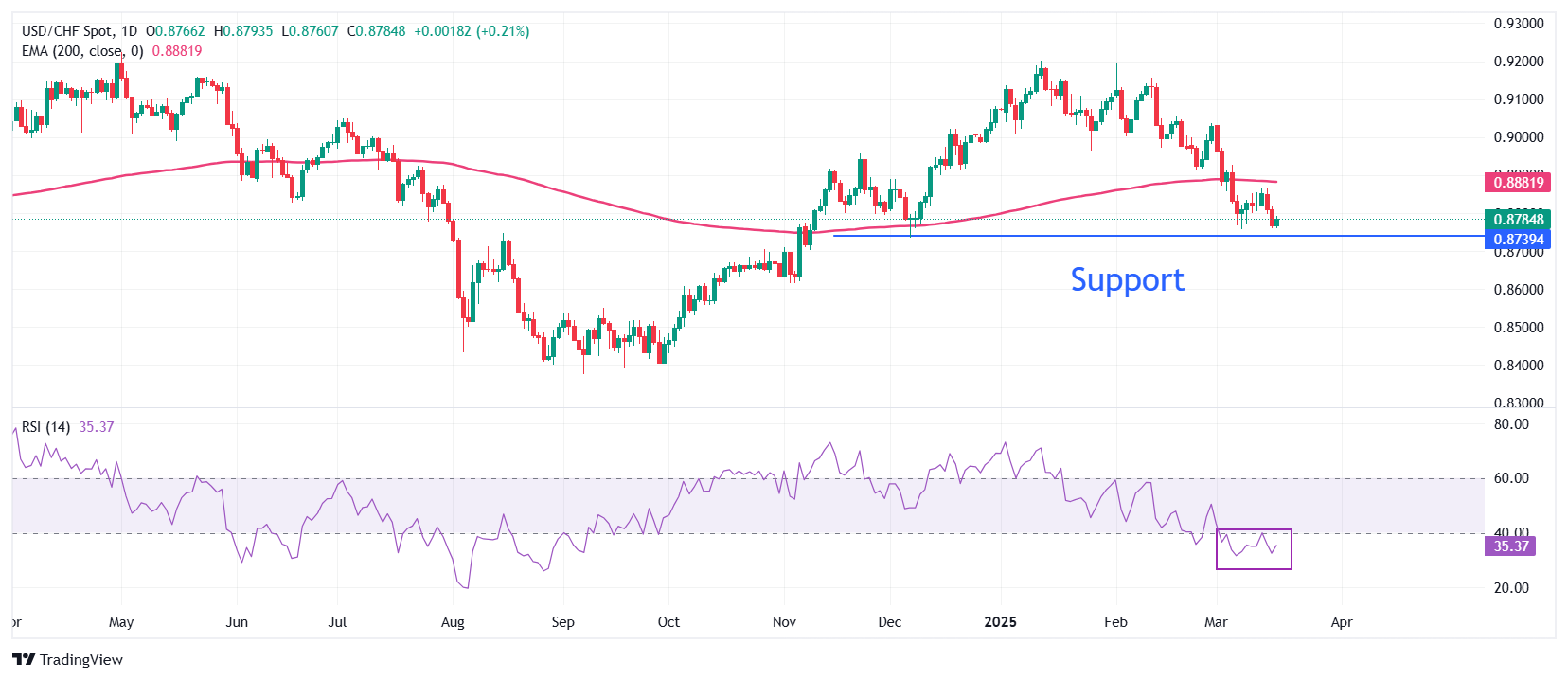USD/CHF Price Forecast: Strives to gain ground near 0.8750 ahead of Fed policy
- USD/CHF finds ground temporarily near 0.8750 ahead of the Fed’s monetary policy decision at 18:00 GMT.
- The Fed is expected to keep interest rates steady for the second time in a row.
- The SNB could maintain an ultra-dovish policy stance amid risks of inflation remaining persistently lower.
The USD/CHF pair attracts bids near the three-month low of 0.8750 during European trading hours on Wednesday. The Swiss Franc pair gains as the US Dollar (USD) rebounds ahead of the outcome of the Federal Reserve’s (Fed) two-day monetary policy meeting at 18:00 GMT.
The US Dollar Index (DXY), which gauges the Greenback’s value against six major currencies, recovers to near 103.70 from the five-month low of 103.20 posted the previous day.
Investors expect the Fed to leave interest rates unchanged in the range of 4.25%-4.50% for the second time in a row as officials need time to get clarity over United States (US) President Donald Trump’s economic policies. The Fed will also release the dot plot, which shows where policymakers see the Federal funds rate heading in the medium and long term, and the Summary of Economic Projections (SEP).
Meanwhile, the Swiss Franc (CHF) underperforms as investors expect the Swiss National Bank (SNB) to follow an ultra-dovish policy-easing approach amid deepening risks of inflation remaining persistently lower. Swiss Consumer Price Index (CPI) decelerated to 0.3% in 12 months to February.
USD/CHF is inching closer to revisiting the four-month low of 0.8736 plotted from the December 6 low. The outlook of the pair is broadly bearish as it trades below the 200-day Exponential Moving Average (EMA), which is around 0.8882.
The momentum is on the bearish side as the 14-day Relative Strength Index (RSI) oscillates in the 20.00-40.00 range.
The asset could face more downside towards the November 8 low of 0.8700 and the November 6 low of 0.8620 if it falls below the December 6 low of 0.8736.
On the flip side, a recovery move above the psychological support of 0.9000 would drive the asset towards the February 28 high of 0.9036, followed by the round-level resistance of 0.9100.
USD/CHF daily chart

US Dollar FAQs
The US Dollar (USD) is the official currency of the United States of America, and the ‘de facto’ currency of a significant number of other countries where it is found in circulation alongside local notes. It is the most heavily traded currency in the world, accounting for over 88% of all global foreign exchange turnover, or an average of $6.6 trillion in transactions per day, according to data from 2022. Following the second world war, the USD took over from the British Pound as the world’s reserve currency. For most of its history, the US Dollar was backed by Gold, until the Bretton Woods Agreement in 1971 when the Gold Standard went away.
The most important single factor impacting on the value of the US Dollar is monetary policy, which is shaped by the Federal Reserve (Fed). The Fed has two mandates: to achieve price stability (control inflation) and foster full employment. Its primary tool to achieve these two goals is by adjusting interest rates. When prices are rising too quickly and inflation is above the Fed’s 2% target, the Fed will raise rates, which helps the USD value. When inflation falls below 2% or the Unemployment Rate is too high, the Fed may lower interest rates, which weighs on the Greenback.
In extreme situations, the Federal Reserve can also print more Dollars and enact quantitative easing (QE). QE is the process by which the Fed substantially increases the flow of credit in a stuck financial system. It is a non-standard policy measure used when credit has dried up because banks will not lend to each other (out of the fear of counterparty default). It is a last resort when simply lowering interest rates is unlikely to achieve the necessary result. It was the Fed’s weapon of choice to combat the credit crunch that occurred during the Great Financial Crisis in 2008. It involves the Fed printing more Dollars and using them to buy US government bonds predominantly from financial institutions. QE usually leads to a weaker US Dollar.
Quantitative tightening (QT) is the reverse process whereby the Federal Reserve stops buying bonds from financial institutions and does not reinvest the principal from the bonds it holds maturing in new purchases. It is usually positive for the US Dollar.


